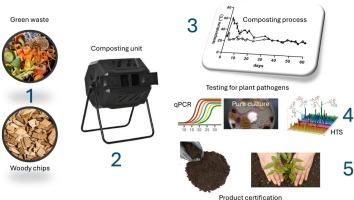植物病原体在生物废物堆肥过程中的存活:卵菌和真菌的案例研究
IF 8
1区 环境科学与生态学
Q1 ENVIRONMENTAL SCIENCES
引用次数: 0
摘要
由于泥炭对环境的影响,欧洲国家已经实施了减少在园艺中使用泥炭的国家战略。研究表明,使用堆肥作为替代品,在不影响盆栽园艺植物生长发育的情况下,减少泥炭消耗的可能性。但是,生产任何替代品都必须考虑泥炭采用的质量标准和要求。其中,植物病原体污染堆肥的风险特别高。此外,评估堆肥过程中特定植物病原体的存活需要适当的检测方法。本研究评估了作为模式植物病原体的卵霉菌肉桂疫霉(Phytophthora cinnamomi)在人工接种的蓖麻(Castanea sativa)树苗的木屑中作为堆肥过程中的填充剂的存活和存在。评估的检测技术包括纯培养分离、定量PCR和高通量测序。利用诱饵和分子条形码技术,在堆肥过程开始时,在木屑中很容易检测到病原菌。在成熟阶段结束时,任何诊断方法(包括诱饵)都没有检测到肉桂假单孢菌,这证实了适当的堆肥过程在根除病原体方面的功效。HTS方法还能够在整个过程中检测到天然存在于绿色残留物和散装剂中的植物病原真菌属的DNA。这些发现对于开发将纳入堆肥生物安全认证协议的诊断管道至关重要。最后,本研究证明了处理回收的园艺生物废物以获得高质量和安全的堆肥的可能性,而不需要复杂和昂贵的堆肥工厂。本文章由计算机程序翻译,如有差异,请以英文原文为准。

Survival of plant pathogens during composting of bio-waste: a case study for oomycetes and fungi
European countries have implemented national strategies to reduce the use of peat in horticulture due to its environmental impact. Studies demonstrated the possibility of reducing peat consumption by using compost as a substitute without affecting the growth and development of potted horticulture plants. However, any substitute must be produced considering quality standards and requirements that are adopted for peat. Among others, the risk of contamination of compost with plant pathogens is particularly high. Furthermore, the assessment of the survival of specific plant pathogens during the composting process requires proper detection methods. This study evaluated the survival/presence of the oomycete Phytophthora cinnamomi, as a model plant pathogen, in woody chips of artificially inoculated Castanea sativa saplings used as a bulking agent in composting processes. Detection techniques for assessment included isolation in pure culture, quantitative PCR (qPCR) and High Throughput Sequencing (HTS). The pathogen was easily detected in woody chips at the beginning of the composting process with baiting and molecular barcoding. By the end of the maturation phase, no P. cinnamomi was detectable by any diagnostic method including baiting, confirming the efficacy of a proper composting process in eradicating the pathogen. HTS approach was also able to detect throughout the process the DNA of plant pathogenic fungal genera naturally present in the green residues and bulk agents. These findings are crucial for developing diagnostic pipelines to be included in protocols for compost biosafety certification. Finally, the present study demonstrated the possibility of processing recycled horticulture biowaste to obtain high-quality and safe compost without the need for complex and expensive composting plants.
求助全文
通过发布文献求助,成功后即可免费获取论文全文。
去求助
来源期刊

Science of the Total Environment
环境科学-环境科学
CiteScore
17.60
自引率
10.20%
发文量
8726
审稿时长
2.4 months
期刊介绍:
The Science of the Total Environment is an international journal dedicated to scientific research on the environment and its interaction with humanity. It covers a wide range of disciplines and seeks to publish innovative, hypothesis-driven, and impactful research that explores the entire environment, including the atmosphere, lithosphere, hydrosphere, biosphere, and anthroposphere.
The journal's updated Aims & Scope emphasizes the importance of interdisciplinary environmental research with broad impact. Priority is given to studies that advance fundamental understanding and explore the interconnectedness of multiple environmental spheres. Field studies are preferred, while laboratory experiments must demonstrate significant methodological advancements or mechanistic insights with direct relevance to the environment.
 求助内容:
求助内容: 应助结果提醒方式:
应助结果提醒方式:


